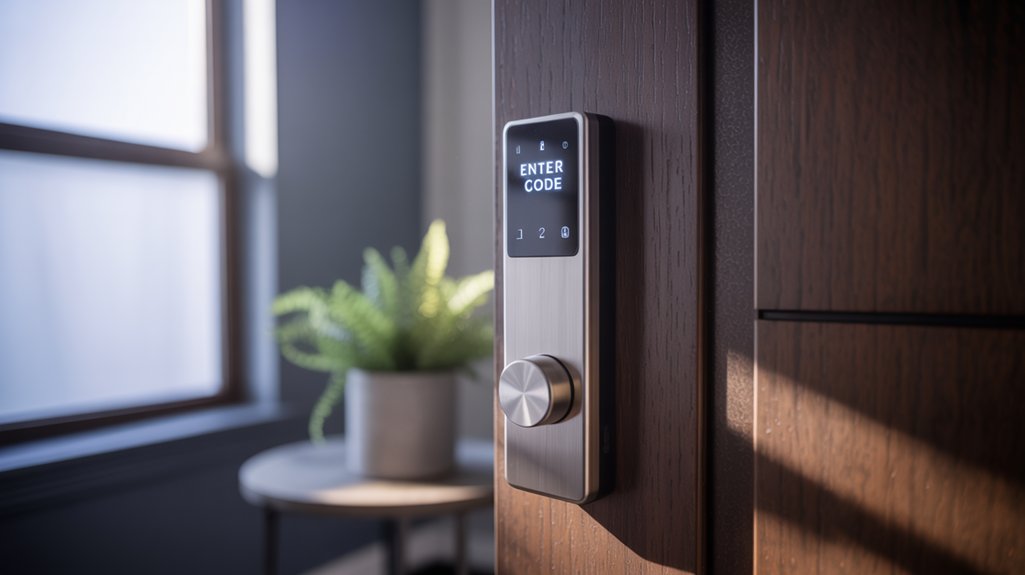You’ll integrate cameras, sensors, and AI through a central hub that orchestrates automated responses to detected threats. Start by positioning 1080p+ cameras at entry points with IR capabilities for night vision, then install motion sensors 6-8 feet high at strategic choke points. Configure your hub to process sensor data through AI algorithms that distinguish between authorized residents and genuine intrusions, triggering automated locks, lighting, and alerts. This foundation enables sophisticated response protocols that adapt to your specific security requirements and household patterns.
Key Takeaways
- Install cameras with 1080p+ resolution and IR night vision at entry points, paired with motion sensors mounted 6-8 feet high at choke points.
- Integrate devices through a central hub supporting Z-Wave, Zigbee, and Wi-Fi protocols on a dedicated VLAN for secure cross-device communication.
- Configure AI-powered automated responses like locking doors, activating lights, and triggering alarms when sensors detect unauthorized motion or entry.
- Train AI algorithms to recognize family members and reduce false alarms, maintaining detection accuracy above 95% through quarterly recalibration.
- Establish hierarchical alert protocols with escalation sequences based on threat severity, ensuring real-time notifications through prioritized bandwidth allocation.
Understanding the Core Components of Automated Home Security Systems

Modern home security automation operates through the integration of four foundational components: sensors, controllers, communication protocols, and response mechanisms.
You’ll need to understand how these elements form a cohesive architecture before deployment.
Sensors detect environmental changes—motion, glass breaks, door contacts, and thermal signatures.
Controllers process this data and execute programmed responses through your central hub or distributed edge devices.
Communication protocols (Z-Wave, Zigbee, Wi-Fi) transmit commands between components with varying latency and reliability profiles.
Your core functionality analysis must evaluate each component’s role in the threat detection chain.
Security system types range from professionally monitored networks to self-administered platforms, each offering distinct control hierarchies.
Response mechanisms include automated locks, lighting triggers, alarm activation, and emergency service notifications.
You’ll configure these based on threat severity and your risk tolerance.
Advanced systems now incorporate Smart Video Search capabilities that allow you to filter through recorded footage using AI-powered detection for specific events like person, package, or vehicle alerts.
Master the interplay between these components to achieve true command over your security infrastructure.
Choosing the Right Smart Cameras for Indoor and Outdoor Monitoring
When selecting smart cameras for your home security system, you’ll need to evaluate three critical specifications that directly impact monitoring effectiveness.
Indoor cameras require minimum 1080p resolution for facial recognition, while outdoor units must meet IP65 or higher ratings to withstand environmental exposure.
Additionally, infrared or low-light sensor capabilities determine whether your cameras can capture usable footage in darkness, making night vision a non-negotiable feature for 24/7 surveillance coverage.
For enhanced privacy and reliability, consider smart video doorbells that offer local storage options instead of relying solely on cloud-based recording systems.
Resolution and Image Quality
Image resolution determines the level of detail your security cameras capture, directly impacting your ability to identify faces, license plates, and suspicious activities.
You’ll need minimum 1080p for basic monitoring, but 4K cameras deliver superior image clarity for critical identification tasks at distances exceeding 30 feet. Pixel density directly correlates with your system’s forensic capabilities—higher density enables digital zoom without significant degradation.
Consider your deployment zones strategically. Wide-angle coverage demands higher resolution to maintain detail across the frame. Low-light performance matters equally; prioritize cameras with larger sensors and advanced image processing.
You’re building a surveillance infrastructure that must perform flawlessly during critical incidents. Select cameras with broad range capabilities exceeding 120dB to capture detail in high-contrast scenarios. Your security posture depends on actionable footage.
Weather Resistance Requirements
Environmental exposure dictates your camera’s operational lifespan and reliability. You’ll need cameras with appropriate waterproof ratings and temperature resistance for uninterrupted surveillance operations. Outdoor installations demand IP66 or IP67-rated enclosures to withstand rain, dust, and debris penetration.
| IP Rating | Protection Level | Deployment Zone |
|---|---|---|
| IP65 | Water jets, dust | Covered patios |
| IP66 | Heavy rain, dust | Exposed walls |
| IP67 | Temporary immersion | Ground-level areas |
| IP68 | Continuous submersion | Pool monitoring |
| Military-spec | -40°F to 140°F | Extreme climates |
Temperature resistance matters equally. Select cameras rated for -40°F to 140°F in regions experiencing temperature extremes. Heating elements and cooling systems maintain sensor accuracy during environmental stress. Your surveillance infrastructure depends on matching equipment specifications to deployment conditions—compromise here creates system vulnerabilities.
Night Vision Capabilities
Low-light performance separates functional surveillance systems from security theater.
You’ll need cameras equipped with infrared technology that automatically switches when ambient light drops below operational thresholds. Look for IR LEDs rated at 850nm wavelength—they provide invisible illumination extending 100+ feet while maintaining stealth operations.
Evaluate low light performance through minimum illumination specs measured in lux. Professional-grade cameras operate at 0.01 lux or lower without IR assistance.
Starlight sensors capture color footage in near-darkness, preserving vital identification details that monochrome IR footage sacrifices.
Consider IR cut filters that mechanically switch between day and night modes, preventing washed-out daytime imagery.
Installation requires positioning cameras where IR won’t reflect off nearby surfaces, creating blind spots.
Test your system’s actual night coverage—manufacturer specifications rarely match real-world performance.
Strategic Placement of Motion Sensors and Entry Point Detectors
Every security system’s effectiveness hinges on precise sensor placement that accounts for intrusion pathways, detection zones, and environmental variables.
Position motion sensors at choke points where intruders must pass—hallway intersections, stairwell landings, and room corners with 110-degree coverage angles. Mount devices 6-8 feet high, angled downward to eliminate blind spots beneath the detection plane.
For entry detection, install magnetic contact sensors on all ground-floor windows and doors, plus basement access points. You’ll need dual-technology sensors combining passive infrared and microwave detection in areas with HVAC vents or pets that trigger false alarms.
Place glass-break detectors within 25 feet of protected windows, ensuring unobstructed acoustic pathways.
Your perimeter defense requires overlapping sensor zones—when one detector’s range ends, another begins. Deploy outdoor motion sensors 15-20 feet from building facades, adjusting sensitivity thresholds to ignore vegetation movement while capturing human-sized thermal signatures.
Map each sensor’s field-of-view before finalizing placement.
Leveraging AI and Machine Learning for Intelligent Threat Detection

Modern AI-driven security systems distinguish between genuine threats and benign activity through neural networks trained on millions of event patterns.
You’ll deploy threat classification algorithms that analyze behavioral indicators—distinguishing a prowler from a neighborhood cat or swaying branches. These systems learn your household’s baseline patterns, enabling precise anomaly detection when deviations occur.
Configure your AI models to recognize specific threat signatures: forced entry attempts, loitering behavior, unusual access times, or unexpected vehicle presence.
Advanced systems process facial recognition data, identifying authorized individuals versus unknown parties. You’ll establish confidence thresholds that trigger appropriate responses—silent monitoring for low-probability events, immediate alerts for confirmed threats.
Machine learning continuously refines its accuracy through feedback loops. When you mark false positives, the system adapts its parameters.
This iterative process converts your security infrastructure into an intelligent defense mechanism that anticipates vulnerabilities and neutralizes risks before they escalate into actual breaches.
Integrating Your Security Devices Into a Unified Smart Home Network
While standalone security devices provide isolated protection, true operational efficiency emerges when you architect a unified network topology that enables cross-device communication and coordinated response protocols.
You’ll establish control by implementing a central hub that manages device compatibility across manufacturers and communication standards—whether Z-Wave, Zigbee, or WiFi-based protocols.
Deploy network segmentation to isolate your security infrastructure from general household traffic.
Segregating your security devices onto isolated network segments prevents unauthorized access while maintaining operational separation from routine household connectivity.
Configure a dedicated VLAN that restricts lateral movement and minimizes attack surfaces. You’ll strengthen network security through WPA3 encryption, certificate-based authentication, and regular firmware validation across all endpoints.
Implement automation rules that trigger cascading responses: motion detection activates cameras, locks doors, and illuminates pathways simultaneously.
You’ll create redundancy by establishing backup communication paths—cellular failover guarantees system integrity during internet outages.
Monitor bandwidth allocation to prevent congestion during multi-device events.
Prioritize security traffic through QoS policies, assuring real-time data transmission when threats materialize.
Setting Up Automated Responses and Custom Alert Protocols

How do you convert passive monitoring into actionable security intelligence?
You’ll engineer automated responses that execute predetermined actions when specific triggers activate. Configure your system to lock doors, illuminate perimeters, and activate sirens when motion sensors detect intrusion patterns. Program cameras to track movement and relay footage to your devices instantaneously.
Custom alerts distinguish between routine events and genuine threats. You’ll establish hierarchical notification protocols: text messages for minor breaches, phone calls for critical incidents, and emergency service dispatches for confirmed intrusions. Train your AI to recognize family members, pets, and authorized personnel, eliminating false alarms that undermine system credibility.
Define response escalation sequences. Initial detection triggers camera activation and silent monitoring. Sustained activity escalates to audible warnings. Continued intrusion initiates full lockdown protocols and emergency notifications.
You’ll create decision trees that adapt responses based on time, location, and threat severity. This changes your network from a recording system into an autonomous defense mechanism that responds before you’re even aware.
Maintaining and Optimizing Your Security Automation System Over Time
Your automated security system degrades without systematic maintenance protocols. Implement quarterly performance checks to verify sensor accuracy, camera resolution consistency, and AI detection rates. Track false positive percentages—anything above 5% demands immediate recalibration.
Execute system updates within 48 hours of release. Firmware vulnerabilities compromise your entire security infrastructure, creating exploitable entry points for sophisticated threats. Configure automatic update notifications and establish redundant backup procedures before deployment.
Monitor storage utilization monthly. Overloaded drives throttle recording quality and processing speed. Archive non-critical footage to external systems and enhance retention policies based on actual security requirements, not default settings.
Overloaded storage systems sabotage your security infrastructure—implement monthly monitoring and archive strategically before degraded performance creates critical vulnerabilities.
Conduct bi-annual stress tests simulating simultaneous sensor activations. Identify bottlenecks in your automation chains before real incidents expose them. Document response times and systematically eliminate latency sources.
Review AI model performance against evolving threat patterns. Retrain detection algorithms using recent footage to maintain recognition accuracy. Your security dominance requires proactive enhancement, not reactive troubleshooting.
Frequently Asked Questions
Can Home Security Automation Systems Work During Internet or Power Outages?
You’ll maintain security during outages if you’ve implemented proper redundancy.
Install battery backup systems for your cameras and control hubs—they’ll sustain operations for 4-24 hours depending on capacity.
Enable offline functionality in your devices to preserve local recording and sensor triggering when internet fails. Your motion detection, door sensors, and sirens won’t require cloud connectivity.
Configure edge processing on cameras to guarantee AI analytics continue functioning independently of external networks.
What Are the Monthly Costs for Cloud Storage and Monitoring Services?
Cloud storage pricing typically ranges from $3-30 monthly, depending on retention period and camera count.
You’ll find monitoring service fees add another $10-60 per month for professional oversight.
Basic plans offer 7-30 days of footage, while premium tiers provide extended retention and AI analytics.
Consider self-hosting options to eliminate recurring costs—you’ll maintain complete control over your data while avoiding subscription dependencies that compromise your system’s long-term operational autonomy.
Do Security Cameras Violate Neighbor Privacy Laws in Residential Areas?
You’re legally compliant if cameras don’t capture beyond your property line—yet 67% of homeowners violate this boundary.
You’ll navigate privacy concerns by angling cameras toward entry points, avoiding neighbor windows and shared spaces.
Legal regulations vary by jurisdiction, but you’re protected when documenting your property perimeter.
Install privacy masking features in your camera firmware to black out restricted zones.
You’ll maintain surveillance authority while respecting boundaries, ensuring your security infrastructure remains legally defensible and operationally effective.
Can Renters Install Security Systems Without Violating Their Lease Agreements?
You’ll achieve lease compliance by selecting non-permanent installation options that don’t compromise structural integrity.
Deploy wireless systems with adhesive mounts, magnetic sensors, and battery-powered cameras—technologies that won’t breach your agreement’s modification clauses.
Review your lease’s specific language regarding alterations before proceeding. Command-and-control hubs requiring drilling typically violate terms, but modern systems offer removable alternatives.
Document your pre-installation property condition thoroughly. You’re maintaining reversibility while establishing extensive security coverage through strategic equipment selection.
How Do Insurance Companies Discount Premiums for Automated Security Systems?
Your security fortress becomes currency in the insurance marketplace.
You’ll command premium discounts of 5-20% when you implement professionally-monitored automated systems with verified UL certificates.
Insurance carriers quantify your risk reduction through central station monitoring, real-time breach detection, and emergency response integration.
You must document your system’s capabilities—motion sensors, AI-powered cameras, smart locks—then submit certification to your provider.
Strategic deployment of automation converts your property into a low-risk asset, directly translating technological superiority into financial advantage.
Conclusion
You’ve architected your digital fortress—cameras scanning perimeters, sensors tracking every entry point, AI algorithms processing data streams in real-time. Your automated security network now operates like a vigilant nervous system, responding to threats before you’re even aware. Monitor your dashboard regularly, update firmware monthly, and refine detection parameters as patterns emerge. This isn’t a set-and-forget installation—it’s a living system that grows sharper with your continuous optimization and systematic fine-tuning.




